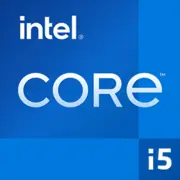Intel Core i5-8257U

Intel Core i5-8257U: Balancing Performance and Battery Life in Ultraportables of 2025
An up-to-date review of the processor for those seeking reliability without overspending
Architecture and Process Technology: Coffee Lake in the Era of 3nm
Despite being built on a 14nm process technology (codenamed Coffee Lake), the Intel Core i5-8257U remains in demand in budget ultraportables of 2025. Its architecture includes:
- 4 cores and 8 threads thanks to Hyper-Threading;
- A base frequency of 1.4 GHz and turbo mode up to 3.9 GHz;
- Integrated graphics with Intel Iris Plus 645, featuring 48 execution units (EU) and 4K support.
CPU Features:
- Optimization for multitasking: 4 cores can handle parallel processes (e.g., streaming + working in Photoshop);
- Support for DDR4-2400 / LPDDR3-2136 RAM (up to 32 GB).
iGPU Iris Plus 645:
- In 2025, the graphics are modest but sufficient for basic tasks:
- 4K video at 60 Hz;
- Light gaming (CS:GO, Dota 2 on low settings);
- Rendering acceleration in Premiere Pro via Quick Sync.
Compared to modern iGPUs like Intel Xe or AMD Radeon 780M, the Iris Plus 645 falls short in energy efficiency, but its capabilities are adequate for office laptops.
Power Consumption and TDP: 15 Watts as the Standard for Portability
TDP of 15 W is a key parameter for ultraportables, which means:
- Low heat output: laptops with passive or compact active cooling (e.g., Acer Swift 3);
- Ability to operate in thin chassis (up to 15 mm).
However, in turbo mode, power consumption briefly reaches 25 W, requiring effective heat dissipation. In 2025, models based on the i5-8257U often come with modest coolers, leading to throttling under prolonged workloads (e.g., video rendering).
Performance: From Excel to Fortnite
Office Tasks:
- Simultaneous work with 20+ tabs in Chrome, Word, Excel, and Zoom— the processor handles it without lag.
- Running virtual machines (e.g., Ubuntu via VirtualBox) is possible but resource-constrained.
Multimedia:
- Converting a 30-minute 1080p video in HandBrake: ~12-15 minutes (twice as slow as the Ryzen 5 5500U).
- Editing photos in Lightroom: smooth operation with RAW files, but exporting a batch of 100 images will take 6-8 minutes.
Gaming:
- Fortnite (720p, low settings): 40-45 FPS;
- The Sims 4 (1080p, medium settings): 60 FPS;
- Cyberpunk 2077: only via cloud gaming (GeForce NOW).
Turbo Boost Mode:
- At temperatures below 75°C, the processor maintains a frequency of 3.5-3.7 GHz for up to 2-3 minutes, after which it drops to 2.8 GHz.
Usage Scenarios: Who is the i5-8257U Suitable for in 2025?
- Students: For studying (Google Docs, presentations), streaming video, and light gaming.
- Office Workers: Working with email, spreadsheets, and video conferencing.
- Travelers: Compact laptops with battery life of 8+ hours.
Not Suitable for:
- 3D modeling (Blender, AutoCAD);
- Streaming AAA games;
- 4K editing in DaVinci Resolve.
Battery Life: How Long Will the Charge Last?
With a battery capacity of 50 Wh (typical for ultraportables):
- Web surfing: 7-8 hours;
- Video (YouTube, 1080p): 6 hours;
- Maximum load (rendering): 1.5-2 hours.
Power-saving Technologies:
- Intel Speed Shift: Dynamic frequency switching to reduce latency;
- Adaptix Thermal Framework: Smart fan management to minimize noise.
Comparison with Competitors: AMD, Apple, and Previous Generations
1. AMD Ryzen 5 5500U (Zen 2, 7nm):
- Pros: 6 cores, higher multi-threaded performance (+25%), support for DDR4-3200.
- Cons: TDP of 15-25 W, battery life 1-2 hours less.
2. Apple M1 (5nm):
- Pros: 18-hour battery life, twice the speed in single-threaded tasks.
- Cons: macOS, limited compatibility with Windows software.
3. Intel Core i5-1135G7 (Tiger Lake, 10nm):
- Pros: Iris Xe graphics (80 EU), support for PCIe 4.0.
- Cons: Price 20-30% higher.
Pros and Cons of the Core i5-8257U
Strengths:
- Optimal for light tasks;
- Affordable laptop prices ($600-$800);
- Support for Thunderbolt 3 for peripherals.
Weaknesses:
- Outdated 14nm process technology;
- No support for Wi-Fi 6E;
- Limited future-proofing (Windows 12 requires more cores).
Recommendations for Choosing a Laptop
- Type of Device: Ultraportable (e.g., Lenovo IdeaPad Slim 5) or budget laptop (HP Pavilion 15).
- What to Check:
- RAM size: at least 8 GB, preferably 16 GB;
- SSD: 512 GB NVMe for quick booting;
- Screen: IPS panel with 1080p resolution.
Example Models for 2025:
- Acer Swift 3 (SF314-59): 14" screen, 16 GB RAM, 512 GB SSD — $699;
- Dell Inspiron 15 3520: 15.6", 8 GB RAM, 256 GB SSD — $649.
Final Verdict: Who Should Buy?
The Intel Core i5-8257U in 2025 is a choice for those who:
- Are looking for a budget laptop for work and study;
- Value battery life and quiet operation;
- Do not plan to run "heavy" applications.
Key Benefits: Reliability, time-tested architecture, and a price under $800. However, if your budget allows, consider models based on the Ryzen 5 7530U or Intel Core i5-1235U — they offer a better balance of performance and energy efficiency.
Prices are current as of April 2025 for new devices in the USA. When choosing, keep in mind that technology does not stand still, and even a budget laptop should have a buffer for 3-4 years of use.
Basic
CPU Specifications
Memory Specifications
GPU Specifications
Miscellaneous
Benchmarks
Compared to Other CPU
Share in social media
Or Link To Us
<a href="https://cputronic.com/cpu/intel-core-i5-8257u" target="_blank">Intel Core i5-8257U</a>